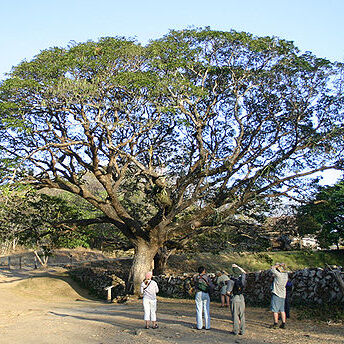Trees, large, unarmed, with spreading crown. Leaves bipinnate; stipules deciduous, lanceolate; pinnae 3-6 pairs, with glands between pinnae on rachis; leaflets opposite. Inflorescences axillary corymbs, pedunculate; bracts small. Flowers dimorphic; central flowers enlarged, 7-or 8-merous; marginal flowers smaller, 5-merous. Calyx shortly lobed. Petals connate to middle. Stamens many, united at base into a tube; anthers not glandular. Ovary sessile; style filiform; ovules many. Legume straight or slightly curved, turgid with thickened margins, woody, indehiscent, septate between seeds. Seeds numerous, strongly biconvex, with pleurogram; aril absent.
Unarmed tree with wide-spreading crown and bipinnate leaves. Leaves: axes with extrafloral nectaries; pinnae 2-6-jugate; leaflets opposite. Inflorescence axillary, with pedunculate clusters of pedicellate flowers. Flowers dimorphic, 5-merous except central ones larger and 7-or 8-merous; calyx and corolla connate and valvate. Stamens numerous, united in a tube towards base; anthers lacking apical gland. Pod turgid, woody, indehiscent. Seeds embedded in pulpy mesocarp in 1-seeded chambers; pleurogram present.
Differs from Cathormion as follows: unarmed; pods straight or slightly curved, transverse impressions between seeds visible externally or not, margins entire (sometimes with one or two constrictions at the base), mesocarp moderately to well developed.

